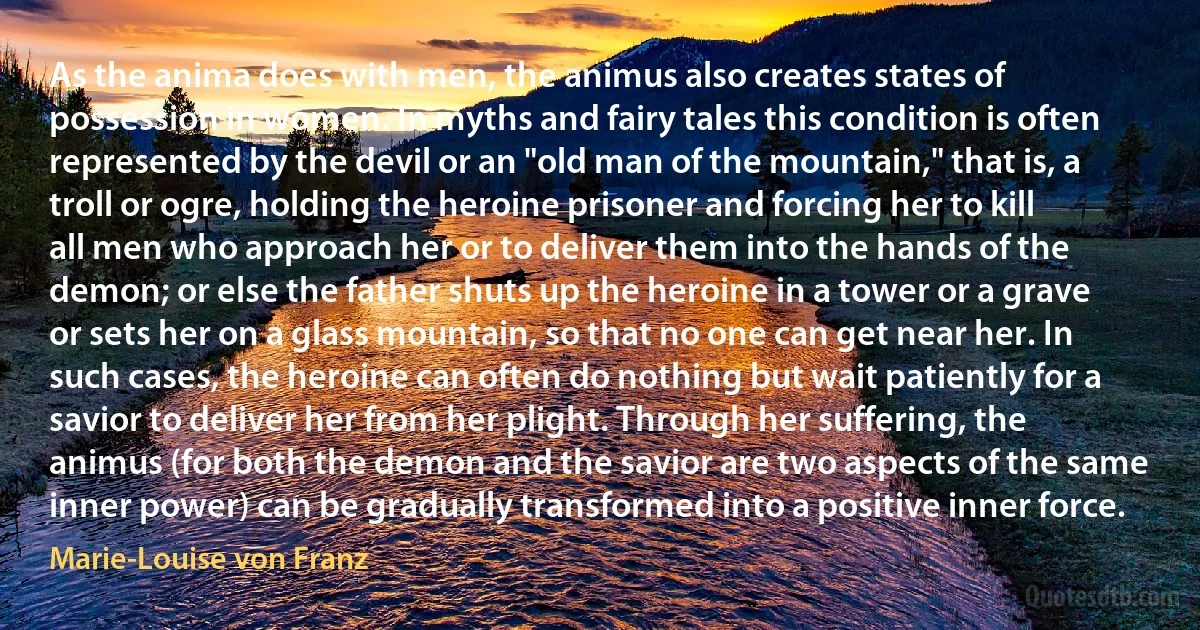
As the anima does with men, the animus also creates states of possession in women. In myths and fairy tales this condition is often represented by the devil or an "old man of the mountain," that is, a troll or ogre, holding the heroine prisoner and forcing her to kill all men who approach her or to deliver them into the hands of the demon; or else the father shuts up the heroine in a tower or a grave or sets her on a glass mountain, so that no one can get near her. In such cases, the heroine can often do nothing but wait patiently for a savior to deliver her from her plight. Through her suffering, the animus (for both the demon and the savior are two aspects of the same inner power) can be gradually transformed into a positive inner force.
Marie-Louise von FranzRelated topics
animus approach condition devil father force glass grave women heroine holding men kill man mountain near nothing plight possession power prisoner savior suffering tales wait anima hands StatesRelated quotes
Take a look at the simplest of objects. Let's take, for example, an old chair. It seems like nothing. But think of the universe comprised within it: the sweaty hands cutting the wood that used to be a robust tree, full of energy, in the middle of a luxuriant forest by some high mountains. The loving work that built it, the joyful anticipation of the one who bought it, the tired bodies it has helped, the pains and the joys it must have endured, whether in fancy halls or in a humble dining room in your neighbourhood. Everything, everything shares life and has its importance! Even the most worn down of chair carries inside the initial force of the sap climbing from the earth, out there in the forest, and will still be useful the day when, broken into kindling, it burns in some fireplace.

Antoni Tàpies
To the biologist the problem of socialism appears largely as a problem of size. The extreme socialists desire to run every nation as a single business concern. I do not suppose that Henry Ford would find much difficulty in running Andorra or Luxembourg on a socialistic basis. He has already more men on his pay-roll than their population. It is conceivable that a syndicate of Fords, if we could find them, would make Belgium Ltd. or Denmark Inc. pay their way. But while nationalization of certain industries is an obvious possibility in the largest of states, I find it no easier to picture a completely socialized British Empire or United States than an elephant turning somersaults or a hippopotamus jumping a hedge.

J. B. S. Haldane
When a person has inwardly struggled with his anima or with her animus for a sufficiently long time and has reached the point where he or she is no longer identified with it in an unconscious fashion, the unconscious once again takes on a new symbolic form in relating with the ego. It then appears in the form of the psychic core, that is, the Self. In the dreams of a woman, the Self, when it personifies itself, manifests as a superior female figure, for example, as a priestess, a sorceress, an earth mother, or a nature or love goddess. In the dreams of a man, it takes the form of some-one who confers initiations (an Indian guru), a wise old man, a nature spirit, a hero, and so forth. An Austrian fairy tale recounts the following:.

Marie-Louise von Franz
Today, many of us picked up our newspapers, and we were horrified to see the sight of 10 American sailors on their knees, with their hands on their heads. In that State of the Union, President Obama didn't so much as mention the 10 sailors that had been captured by Iran. President Obama's preparing to send $100 billion or more to the Ayatollah Khamenei. And I'll tell you, it was heartbreaking. But the good news is the next commander-in-chief is standing on this stage. And I give you my word, if I am elected president, no service man or service woman will be forced to be on their knees, and any nation that captures our fighting men will feel the full force and fury of the United States of America.

Ted Cruz
Before us, art relied on memory, an anxious re-evocation of an Object lost (happiness, love, a landscape), and hence was nostalgic, static, charged with suffering and distance. With Futurism, instead, art is turning into art-action, which is to say, into will, optimism, aggression, possession, penetration, delight, brutal reality within art (example: onomatopoiea; -example: noise-tuners = motors), geometrical splendor of forces, projections forward. Thus, art is becoming Presence, new Object, new reality created with the abstract elements of the universe. The hands of the passéist artist used to suffer for the sake of the lost Object; our hand will twitch for the new Object to be created. That is why the new Object (the plastic complex) has miraculously appeared in your hands.

Filippo Tommaso Marinetti
